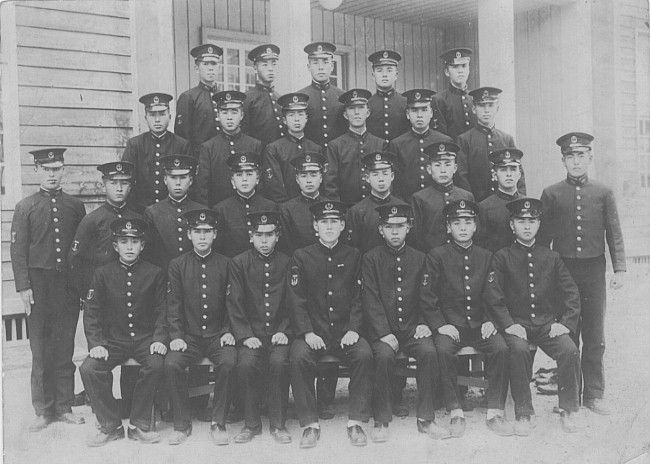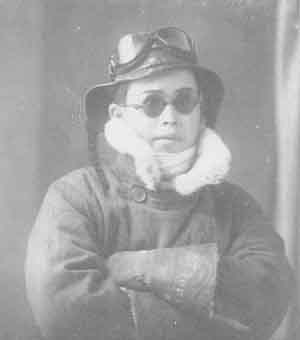|
|||||||||
|
|||||||||
|
This photo, taken on November 3, 1943 (Emperor Meiji's Birthday), shows the 22nd Squadron, 5th Section, at the Kagoshima Naval Air Base. In the middle of the front row is Petty Officer 2nd Class Souji Tajima, Section Leader. Excluding two persons (Korenaga and Tanaka) who transferred to the next class due to illness, 25 of us graduated from flight training and left for operational units. Our section trained on the following planes: fighter - 5 people, carrier dive bomber - 1 person, carrier attack bomber - 7 people, land-based attack bomber - 9 people, and seaplane - 2 people. The following seven people were killed in battle: Yasuda (front row, 2nd from right), Ishibashi (front row, 5th from right), Kishida (front row, 6th from right), Minowa (2nd row, 6th from right), Furuta (2nd row, far left), Yamamura (3rd row, 5th from right), and Hirotomo (last row, 2nd from right). In the second from the right are Nagahama, Gotoh (wounded in battle, now also in hospital), and Nagasue (author). On March 21, 1945, Petty Officer 2nd Class Teruo Ishibashi (Wakayama Prefecture) was killed in line of duty as he plunged into Tokyo Bay while practicing torpedo attacks in formation with the target being the destroyer Yakaze. He was a friend of mine who took the same flight training course for carrier attack bombers at Hyakurigahara Air Base. After graduation, he was assigned to the 254th Attack Flight Corps of the 131st Air Group, where he trained on Tenzan attack bombers. Petty Officer 2nd Class Takuro Yasuda (Hiroshima Prefecture) completed practical flight training for fighters at Tsukuba Air Base. His operating unit was the 308th Fighter Corps of the 601st Air Group, and he joined the Kamikaze Special Attack Corps 3rd Mitate Unit. He sortied from No. 1 Kokubu Air Base in Kagoshima Prefecture. On April 11, 1945, he carried out a body-crashing attack with a Zero fighter loaded with a bomb against the enemy task force to the south of Kikai Island. His distinguished service was announced to the all armed forces in Combined Fleet Bulletin No. 138. Petty Officer 2nd Class Yoshifuji Kishida (Fukuoka Prefecture) specialized in fighters in the same way as Mr. Yasuda and belonged to the 308th Fighter Corps. On April 17, 1945, he boarded a Zero fighter and departed from No. 1 Kokubu Air Base as a member of a group to attack the enemy fleet. He died in battle when he fought several dozen enemy planes about twenty nautical miles southeast of Kikai Island. Petty Officer 1st Class Toshikazu Furuta (Aichi Prefecture) received training on seaplanes at Amakusa Air Base. Afterward, he switched to land-based planes, and he received pilot training for the Zero fighter. He belonged to the 301st Fighter Corps of the 721st Air Group. On May 14, 1945, he boarded a Zero fighter loaded with a bomb as a member of the Kamikaze Special Attack Corps 11th Kenmu Unit. He died for an eternal cause as he carried out a body-crashing attack against the enemy task force to the east of Tanegashima. On May 26, Petty Officer 1st Class Kiyoshi Hirotomo (Okayama Prefecture) died during the ground battle on the main island of Okinawa. On June 13, Petty Officer 1st Class Hisakazu Minowa (Niigata Prefecture) also died in battle as he followed after him. He belonged to the 951st Air Group, and everyone was dispatched to Oroku Base. However, his plane was destroyed by American military attacks, and he became an airman without wings. He died in a fierce battle as part of the land combat forces. On June 5, 1945, Petty Officer 1st Class Teruo Yamamura (Yamaguchi Prefecture) of the 406th Air Attack Corps, 762nd Air Group, boarded a Ginga bomber and sortied from Miyazaki Air Base at 7:50 p.m. He carried out a nighttime torpedo attack against enemy ships in the midst of bad weather, and he did not return. If His Teacher Had Not Recommended Him Several days ago I sent the family of Teruo Yamamura the photo above of the 22nd Squadron, 5th Section, and my book Wings of No Return. I received back the following thank-you letter.
"If his teacher had not recommended him . . . " According to the records, the 406th Air Attack Corps carried out body-crashing attacks and nighttime torpedo attacks at the same time. Several of my classmates who were pilots were transferred from land-based attack bombers at Toyohashi Air Base and from carrier dive bombers at Usa Air Base. Yoshiharu Gotoh, Teruo Yamamura, and Kazutatsu Shimazu were in the group of land-based attack bombers that carried out nighttime torpedo attacks. Kensuke Eto, Manabu Matsuki, Yutaka Furukoji joined kamikaze special attack units that used carrier dive bombers. The sorting of plane types at Yatabe Air Base determined our subsequent fate. Furthermore, my classmates who were observers also fought bravely as they were paired with pilots of carrier dive bombers and land-based attack bombers. When I think of it now, it's difficult to judge which was good fortune and which was bad fortune. His Home Country, the Enemy I will introduce the eventful life of Mr. Tamotsu Minamishin (first row of photo, far left). He was a nisei (second-generation Japanese-American). He came to Japan based on his parents' recommendation, and he studied at Kagoshima Kajiki Middle School. However, his hard life began at the outbreak of World War II. Correspondence with his parents was cut off, and they could not get any news to each other. He applied for the Naval Flight Training Program, willing to die with pride as a true Japanese even though he knew that he would be fighting against his native country. After enduring intense training at the air bases at Kagoshima, Yatabe, and Tsukuba, he participated in battle as a Zero fighter crew member. Unfortunately, he had to make a crash landing and was injured. However, he was able to escape dying in battle. |
|||||||||
|
|||||||||

